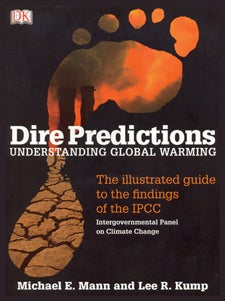
 We frequently mention the IPCC reports on Climate 411 – often referencing them as the most trustworthy authority on global warming science. In fact, our very first blog post was titled "What is the IPCC, anyway?" But for non-scientists, these rather technical reports are a challenge to read.
We frequently mention the IPCC reports on Climate 411 – often referencing them as the most trustworthy authority on global warming science. In fact, our very first blog post was titled "What is the IPCC, anyway?" But for non-scientists, these rather technical reports are a challenge to read.
Climate scientists Michael Mann and Lee Kump published the book Dire Predictions to make the IPCC’s crucially important findings accessible to the layperson. For the most part, they succeed admirably. Mann and Kump did a remarkable job of simplifying complex ideas. But it still gets a little dense in places.
Despite a few bumps, in general I found the book to be an engaging read. The colorful graphics on nearly every page bring abstract concepts to life. The book also benefits from creative and catchy writing, on display in subsection titles such as "Earth, wind and fire" and "Is it time to sell that beach house?".
A Slow Start
If you’re unfamiliar with the basics of climate change, the introduction can bring you up to speed. But if you’re already familiar with the global warming "debate" and you know what causes the seasons to change, you may want to skim the intro and the beginning of Part 1 and dig in at around page 30.
The first 30 pages are dense in places, as well as less engaging. This section abbreviates some information that is presented more understandably later. For example, the graph on page 20 showing climate uncertainties lacks explanation, but there’s a full explanation of the graph where it reappears in Part 2. Another example: the term "longwave radiation" is used on page 19 without prior definition. The glossary in the back of the book can help with unfamiliar terms.
Compelling and Balanced
Throughout the book, the authors’ great wealth of knowledge and mastery of the subject clearly shine through. Dr. Mann was a lead author for a chapter of the IPCC’s Third Assessment Report, and a reviewer of the most recent Fourth Assessment Report. He’s also a co-founder of the highly respected climate blog RealClimate.org. Dr. Kump is the lead author of the preeminent textbook, The Earth System.
One of the strengths of Dire Predictions is its strong, to-the-point rebuttals of common misconceptions fueled by global warming skeptics. The authors expertly explain why the ongoing rise in atmospheric CO2 is not natural, how today’s warming is greater than and fundamentally different from that during the "Medieval Warm Period", why higher CO2 levels are not beneficial for ecosystems, and why the excuses for inaction on global warming are wrong.
The book gives a balanced presentation of the issues, citing the pros and cons of global warming, and at times posing ethical questions for the reader to decide. In fact, sometimes I felt that the authors were a bit too cautious in drawing conclusions – for example, regarding scientists’ ability to predict climate change. Most assertions are backed up with evidence and explanations, and yet the writing remains concise and engaging.
I liked the sections on what individuals can do to stop global warming and how to calculate your carbon footprint. They make the issue more personal.
A Few Rough Edges
I noticed rough edges here and there. The discussion of energy in Part 5, for example, may be confusing to lay readers. The authors use the term "energy supply" to refer only to a particular kind of energy – electricity and heating – and not fuels used in industry and transport. Then they introduce another category of energy, "buildings", which I did not think was clearly distinguished from "energy supply". To confound things further, they categorize fuel cells in vehicles as "energy supply" rather than "transport".
And then there are some errors. The graph of emissions from different economic sectors on the bottom of page 159 is missing the N2O emissions from agriculture for 2004. On pages 56-57, the authors initially define hurricanes as tropical cyclones that occur only in the Atlantic Ocean basin, but later mention "all of the major hurricane basins." The authors tell me that at least some of these errors will be corrected in the second printing.
But these problems are minor. Overall, Mann and Kump managed to pack a lot of information on the huge topic of climate change into a small amount of space, with engaging prose and illustrations throughout. If you’d like an understandable summary of the IPCC’s findings, you’ll appreciate Dire Predictions.
This post is by James Wang, Ph.D., a climate scientist at Environmental Defense Fund.









